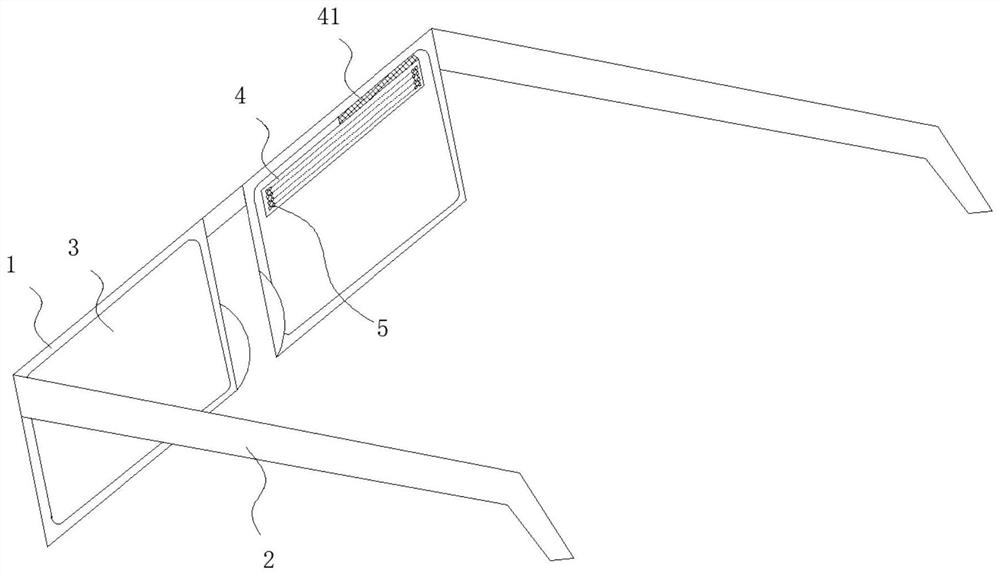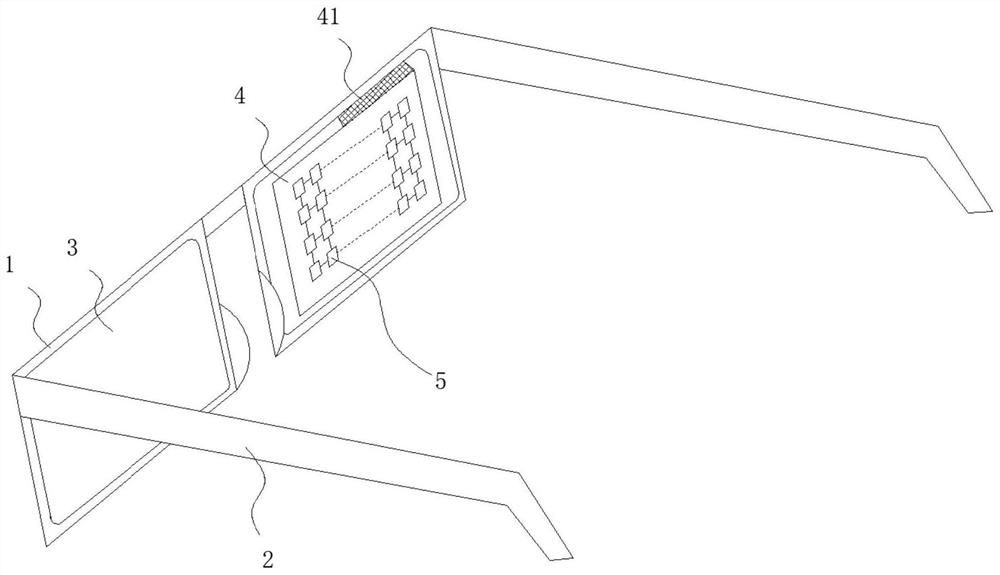Augmented reality glasses based on MicroLED display
An augmented reality and glasses technology, applied in optical components, optics, instruments, etc., can solve the problems of users' visual discomfort and difficulty in eye tracking, and achieve the effect of meeting high integration requirements, improving robustness, and avoiding bulky
- Summary
- Abstract
- Description
- Claims
- Application Information
AI Technical Summary
Problems solved by technology
Method used
Image
Examples
Embodiment 1
[0028] Please refer to figure 1 , an augmented reality glasses based on MicroLED display includes a lens frame 1, a mirror leg 2 and a lens 3, two lenses 3 and two mirror legs 2 are provided, and the lens 3 is embedded in the lens frame 1, so The temples 2 are arranged on the left and right sides of the lens frame 1, wherein at least one lens 3 is provided with a MicroLED display unit 4 on the inner surface, and the MicroLED display unit 4 includes a transparent substrate and a pixel unit. Arranged in an array on the substrate, each pixel unit includes a driving unit and a MicroLED chip 5, the driving unit is arranged between the transparent substrate and the MicroLED chip 5, and the MicroLED chip 5 includes a visible light MicroLED chip and an infrared light MicroLED chip The light emitted by the visible light MicroLED chip is in the visible light band for realizing monochrome display; the light emitted by the infrared light MicroLED chip is in the infrared band for providing...
Embodiment 2
[0036] Please refer to Figure 2 to Figure 3 The difference between the second embodiment and the first embodiment is that the visible light MicroLED chip 5 includes a first MicroLED chip 51, a second MicroLED chip 52 and a third MicroLED chip 53, and the wavelength of the light emitted by the first MicroLED chip 51 is Between 400nm and 500nm, the peak wavelength is 450nm, emitting blue light. The first MicroLED chip 51 contains at least one multi-quantum well light-emitting layer, which is formed by alternately stacking two semiconductor layers with different components and a thickness on the nanometer scale. The general chemical formula of the two semiconductor layers is Al x In y Ga z N (where x+y+z=1, 0≤x≤1, 0≤y≤1, 0≤z≤1). The wavelength of light emitted by the second MicroLED chip 52 is between 500 nm and 600 nm, with a peak wavelength of 525 nm, and emits green light. The second MicroLED chip 52 contains at least one multi-quantum well light-emitting layer, which is ...
PUM
| Property | Measurement | Unit |
|---|---|---|
| wavelength | aaaaa | aaaaa |
| wavelength | aaaaa | aaaaa |
| wavelength | aaaaa | aaaaa |
Abstract
Description
Claims
Application Information
 Login to View More
Login to View More - R&D
- Intellectual Property
- Life Sciences
- Materials
- Tech Scout
- Unparalleled Data Quality
- Higher Quality Content
- 60% Fewer Hallucinations
Browse by: Latest US Patents, China's latest patents, Technical Efficacy Thesaurus, Application Domain, Technology Topic, Popular Technical Reports.
© 2025 PatSnap. All rights reserved.Legal|Privacy policy|Modern Slavery Act Transparency Statement|Sitemap|About US| Contact US: help@patsnap.com



